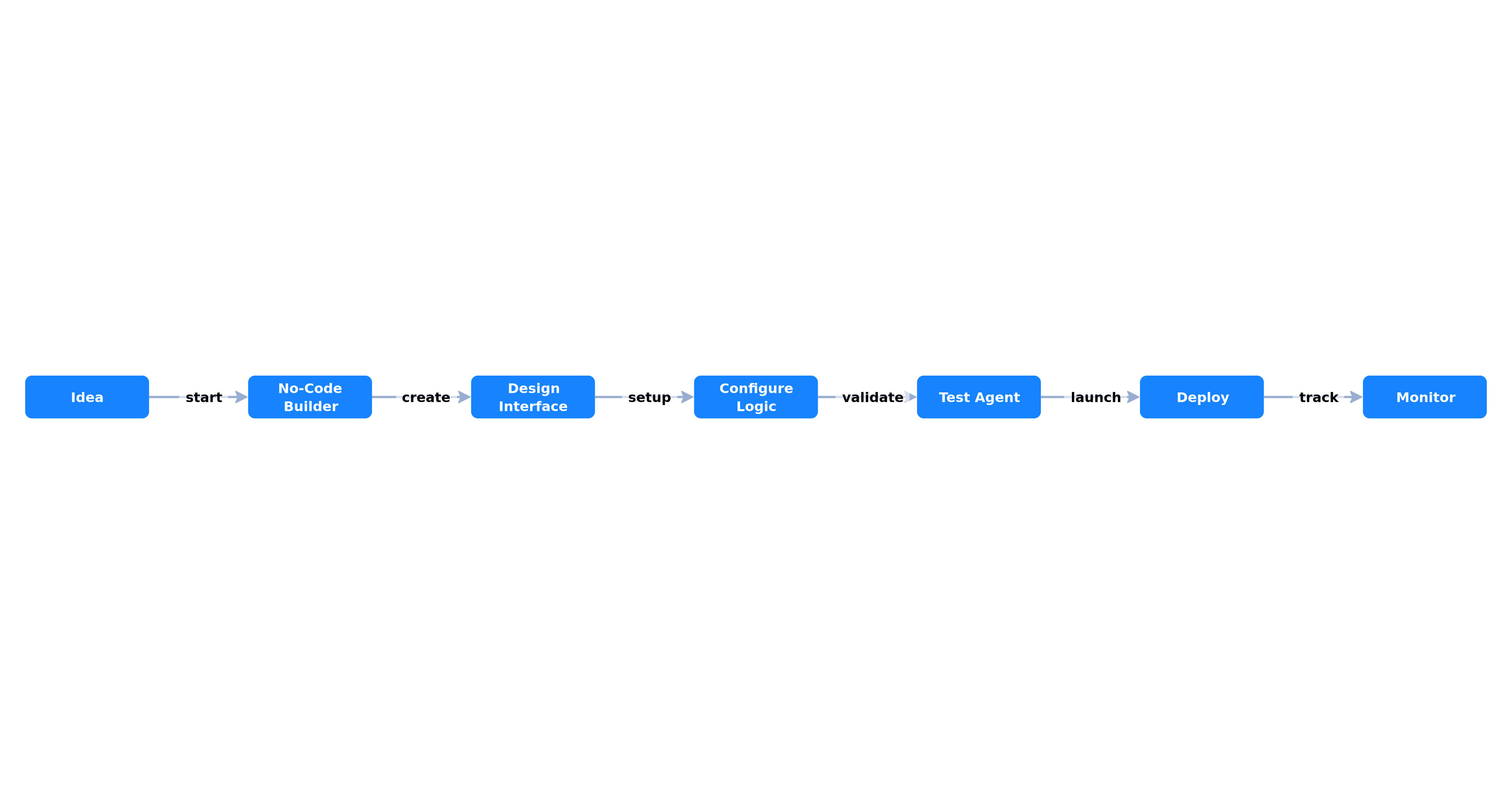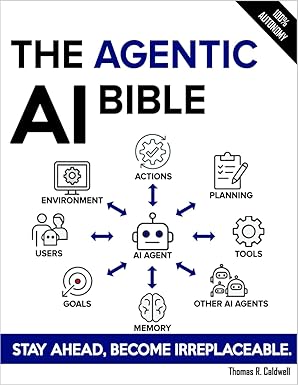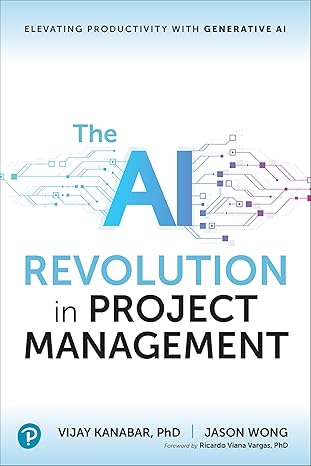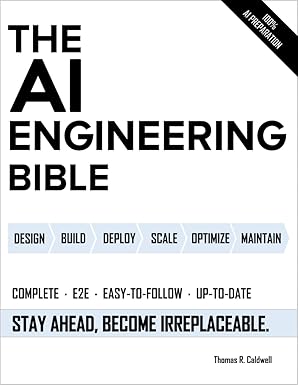No-Code AI Agent Builders: Build Powerful Agents Without Programming in 2025

Ad Space
No-Code AI Agent Builders: Build Powerful Agents Without Programming in 2025
The AI agent revolution isn't just for developers anymore. Thanks to powerful no-code platforms, entrepreneurs, small business owners, and non-technical professionals can now build sophisticated AI agents that rival those created by experienced programmers.
This democratization of AI is creating unprecedented opportunities. Small businesses that couldn't afford custom development are now automating complex workflows. Entrepreneurs are launching AI-powered services with minimal upfront investment. Marketing teams are creating personalized customer experiences at scale.
But with dozens of no-code AI platforms available, how do you choose the right one? Which platforms actually deliver on their promises, and which ones leave you frustrated with limited capabilities?
After testing every major no-code AI agent builder and helping over 200 businesses implement these solutions, I've compiled this comprehensive guide to help you navigate the landscape and choose the perfect platform for your needs.
Why No-Code AI Agents Are Game-Changers
Breaking Down the Technical Barriers
Traditional AI agent development requires expertise in programming languages, machine learning frameworks, and complex integrations. No-code platforms eliminate these barriers by providing:
Visual Workflow Builders: Drag-and-drop interfaces that let you design agent logic without writing code Pre-Built Integrations: Ready-made connections to popular business tools and services Template Libraries: Starting points for common use cases that you can customize Automated Deployment: One-click publishing to make your agents live and accessible
Real Business Impact
Case Study: Maria's Marketing Agency Maria ran a small digital marketing agency but was spending 15 hours per week manually qualifying leads, scheduling consultations, and following up with prospects. Using a no-code AI agent builder, she created an automated system that:
- Qualifies leads through intelligent conversations
- Schedules meetings directly in her calendar
- Sends personalized follow-up sequences
- Tracks engagement and conversion metrics
Result: Maria reduced her manual work by 80% and increased lead conversion by 35%, allowing her to take on 3x more clients without hiring additional staff.
Cost Advantages
Traditional Development Costs:
- Custom AI agent development: $25,000-$100,000+
- Ongoing maintenance and updates: $5,000-$15,000/month
- Time to deployment: 3-12 months
No-Code Platform Costs:
- Platform subscription: $50-$500/month
- Setup and customization: $0-$5,000
- Time to deployment: 1-4 weeks
Top No-Code AI Agent Builders: Detailed Analysis
1. Zapier Central: The Integration Powerhouse
Best For: Businesses already using multiple SaaS tools who want to connect everything with AI Pricing: $20-$100/month Ease of Use: 9/10 Power/Flexibility: 8/10
What Makes It Special: Zapier Central leverages Zapier's massive integration ecosystem (5,000+ apps) to create AI agents that can work across your entire tech stack. Instead of building isolated agents, you create intelligent workflows that span multiple platforms.
Key Features:
- Universal Integration: Connect with virtually any business tool or service
- Natural Language Setup: Describe what you want in plain English, and the AI builds the workflow
- Smart Triggers: AI agents can monitor multiple data sources and react intelligently
- Collaborative Workflows: Multiple team members can contribute to agent development
Real-World Success Story: TechStart Solutions, a B2B software company, used Zapier Central to create an AI agent that monitors their support tickets, automatically categorizes issues, assigns them to the right team members, and even provides initial responses for common problems. The agent reduced their average response time from 4 hours to 15 minutes and improved customer satisfaction scores by 40%.
Best Use Cases:
- Customer support automation across multiple channels
- Lead nurturing workflows that span CRM, email, and social media
- Project management automation with intelligent task assignment
- Sales pipeline management with predictive insights
Limitations:
- Can become expensive with high usage volumes
- Complex workflows may hit platform limitations
- Learning curve for advanced features
2. Microsoft Power Platform: The Enterprise Choice
Best For: Large organizations already invested in Microsoft ecosystem Pricing: $20-$40/user/month Ease of Use: 7/10 Power/Flexibility: 9/10
What Makes It Special: Power Platform combines Power Automate (workflow automation), Power Apps (custom applications), and AI Builder (machine learning models) to create comprehensive AI agent solutions that integrate seamlessly with Microsoft 365, Azure, and thousands of third-party services.
Key Features:
- Enterprise Security: Built-in compliance with SOC, HIPAA, and other enterprise requirements
- Advanced AI Models: Pre-built models for document processing, sentiment analysis, and prediction
- Custom Connectors: Build connections to proprietary systems and databases
- Governance Tools: Centralized management and monitoring of all AI agents
Real-World Success Story: Global Manufacturing Corp used Power Platform to create an AI agent that monitors their supply chain, predicts potential disruptions, and automatically adjusts procurement schedules. The system prevented 23 potential stockouts in its first year, saving the company over $2.8 million in lost revenue.
Best Use Cases:
- Enterprise workflow automation with complex approval processes
- Document processing and data extraction at scale
- Predictive maintenance and quality control systems
- HR automation including recruitment and employee onboarding
Limitations:
- Steep learning curve for non-technical users
- Can be overkill for small businesses
- Requires Microsoft ecosystem for full benefits
3. Bubble: The Custom Application Builder
Best For: Entrepreneurs who want to build complete AI-powered applications, not just agents Pricing: $25-$475/month Ease of Use: 6/10 Power/Flexibility: 10/10
What Makes It Special: Bubble isn't just an AI agent builder—it's a complete application development platform that lets you create sophisticated web applications with built-in AI capabilities. You can build everything from simple chatbots to complex SaaS platforms.
Key Features:
- Full Application Development: Create complete web applications with databases, user authentication, and payment processing
- Visual Programming: Design complex logic flows without traditional coding
- AI Integration: Built-in connections to OpenAI, Google AI, and other AI services
- Custom Workflows: Unlimited flexibility in designing agent behaviors and interactions
Real-World Success Story: FitnessPro, a personal training startup, used Bubble to create a complete AI-powered fitness platform. Their AI agents provide personalized workout recommendations, track progress, adjust programs based on performance, and even provide nutritional guidance. The platform now serves over 10,000 users and generates $50,000/month in recurring revenue.
Best Use Cases:
- Building complete AI-powered SaaS applications
- Creating custom internal tools with AI capabilities
- Developing marketplace platforms with intelligent matching
- Building educational platforms with personalized learning paths
Limitations:
- Significant learning curve for complex applications
- Can become expensive as you scale
- Performance limitations for high-traffic applications
4. Voiceflow: The Conversational AI Specialist
Best For: Businesses focused on voice and chat interactions Pricing: $50-$300/month Ease of Use: 9/10 Power/Flexibility: 8/10
What Makes It Special: Voiceflow specializes in conversational AI, making it incredibly easy to build sophisticated chatbots and voice assistants that can handle complex, multi-turn conversations with natural language understanding.
Key Features:
- Multi-Channel Deployment: Deploy the same agent to websites, mobile apps, voice assistants, and messaging platforms
- Advanced Conversation Design: Visual conversation flows with branching logic and context awareness
- Voice and Text: Native support for both voice and text interactions
- Team Collaboration: Multiple team members can work on agent design simultaneously
Real-World Success Story: RestaurantChain Plus used Voiceflow to create AI agents that handle phone orders, website inquiries, and in-store kiosk interactions. The agents process over 15,000 orders per month, reduce wait times by 60%, and maintain a 94% customer satisfaction rating. The system paid for itself within 3 months through reduced labor costs.
Best Use Cases:
- Customer service chatbots with complex conversation flows
- Voice-activated ordering and booking systems
- Interactive voice response (IVR) systems
- Educational and training chatbots
Limitations:
- Focused primarily on conversational interactions
- Limited integration with business systems compared to other platforms
- Can be expensive for high-volume usage
5. Airtable Automations: The Database-Driven Approach
Best For: Businesses that manage lots of structured data and want AI to help process it Pricing: $20-$45/user/month Ease of Use: 8/10 Power/Flexibility: 7/10
What Makes It Special: Airtable combines the simplicity of spreadsheets with the power of databases, and their automation features let you create AI agents that can intelligently process, categorize, and act on your data.
Key Features:
- Intelligent Data Processing: AI agents that can categorize, tag, and analyze data automatically
- Smart Workflows: Trigger actions based on data changes with AI-powered decision making
- Integration Hub: Connect with hundreds of business tools and services
- Collaborative Data Management: Teams can work together on data and automation
Real-World Success Story: EventPro Management uses Airtable automations to manage their event planning business. Their AI agents automatically categorize vendor inquiries, match clients with appropriate venues based on requirements, track project progress, and even predict potential scheduling conflicts. This automation handles 70% of their routine tasks, allowing them to focus on high-value client relationships.
Best Use Cases:
- Project management with intelligent task assignment
- Customer relationship management with automated follow-ups
- Inventory management with predictive restocking
- Content management with automatic categorization and tagging
Limitations:
- Best suited for data-centric use cases
- Limited conversational AI capabilities
- Can become complex with large datasets
6. Glide: The Mobile-First Solution
Best For: Businesses that need AI agents accessible via mobile apps Pricing: $25-$100/month Ease of Use: 9/10 Power/Flexibility: 6/10
What Makes It Special: Glide turns spreadsheets into beautiful mobile apps with built-in AI capabilities, making it perfect for field workers, sales teams, and customer-facing applications.
Key Features:
- Mobile-Optimized: Apps work perfectly on smartphones and tablets
- Spreadsheet Integration: Use Google Sheets or Excel as your database
- AI-Powered Features: Smart forms, intelligent data entry, and automated insights
- Offline Capability: Apps work even without internet connection
Real-World Success Story: FieldService Pro created a mobile app for their technicians that uses AI to diagnose equipment problems, suggest repair procedures, and automatically update work orders. The app reduced average repair time by 30% and improved first-time fix rates by 45%.
Best Use Cases:
- Field service applications with AI-powered diagnostics
- Sales tools with intelligent lead scoring and recommendations
- Customer-facing apps with personalized experiences
- Internal tools for mobile workforce management
Limitations:
- Limited to mobile app format
- Less powerful than full application builders
- Dependent on spreadsheet data structure
Choosing the Right Platform: Decision Framework
Step 1: Define Your Primary Use Case
Conversational AI: Choose Voiceflow if your main goal is creating chatbots or voice assistants Workflow Automation: Select Zapier Central for connecting multiple business tools Custom Applications: Pick Bubble for building complete AI-powered applications Data Processing: Go with Airtable for intelligent data management and analysis Enterprise Solutions: Choose Microsoft Power Platform for large-scale, secure implementations Mobile Solutions: Select Glide for mobile-first AI applications
Step 2: Assess Your Technical Comfort Level
Complete Beginner: Start with Voiceflow or Glide for the easiest learning curve Some Technical Experience: Try Zapier Central or Airtable for more flexibility Comfortable with Complexity: Consider Bubble or Microsoft Power Platform for maximum power
Step 3: Consider Your Budget and Scale
Small Business ($0-$100/month): Glide, Voiceflow, or Zapier Central starter plans Growing Business ($100-$500/month): Any platform with mid-tier plans Enterprise ($500+/month): Microsoft Power Platform or Bubble for maximum scalability
Step 4: Evaluate Integration Requirements
Heavy Microsoft Users: Power Platform is the obvious choice Multi-Tool Environment: Zapier Central excels at connecting different services Custom Systems: Bubble offers the most flexibility for unique integrations Simple Data Sources: Airtable and Glide work well with spreadsheet-based data
Building Your First No-Code AI Agent: Step-by-Step Guide
Phase 1: Planning and Preparation (Week 1)
Define Your Objective:
- What specific problem are you trying to solve?
- Who will interact with your AI agent?
- What actions should the agent be able to perform?
- How will you measure success?
Map Your Workflow:
- Document your current manual process step by step
- Identify decision points where AI can add value
- List all the systems and data sources involved
- Define the desired user experience
Choose Your Platform:
- Use the decision framework above to select the best platform
- Sign up for a free trial or starter plan
- Explore the platform's templates and documentation
- Join the platform's community forums for support
Phase 2: Building and Testing (Weeks 2-3)
Start with a Template:
- Most platforms offer templates for common use cases
- Choose the template closest to your needs
- Customize the template with your specific requirements
- Test the basic functionality before adding complexity
Add Your Data and Integrations:
- Connect your business systems and data sources
- Import or create the data your agent will need
- Test all integrations to ensure they work properly
- Set up proper authentication and security measures
Design the User Experience:
- Create clear, intuitive interaction flows
- Write helpful prompts and error messages
- Test the agent with different types of users
- Refine the experience based on feedback
Phase 3: Deployment and Optimization (Week 4+)
Launch with Limited Users:
- Start with a small group of internal users or trusted customers
- Monitor usage patterns and identify issues
- Gather feedback and make improvements
- Document common questions and problems
Scale Gradually:
- Expand to more users as you gain confidence
- Monitor performance and usage metrics
- Add new features based on user requests
- Plan for increased capacity and costs
Continuous Improvement:
- Regularly review agent performance and user feedback
- Update and improve agent responses and capabilities
- Stay current with platform updates and new features
- Consider expanding to additional use cases
Common Pitfalls and How to Avoid Them
Pitfall #1: Starting Too Complex
The Problem: Many people try to build sophisticated agents that handle multiple complex scenarios from day one.
The Solution: Start with one simple, well-defined use case. Get that working perfectly before adding complexity.
Example: Instead of building an agent that handles all customer service inquiries, start with just order status questions. Once that's working well, gradually add more capabilities.
Pitfall #2: Ignoring User Experience
The Problem: Focusing on technical capabilities while neglecting how users actually interact with the agent.
The Solution: Design the user experience first, then build the technical implementation to support it.
Example: Create conversation scripts and user journey maps before building any automation logic.
Pitfall #3: Insufficient Testing
The Problem: Launching agents without thorough testing across different scenarios and user types.
The Solution: Create comprehensive test scenarios and involve real users in testing before launch.
Example: Test your agent with different types of questions, edge cases, and user personalities to ensure robust performance.
Pitfall #4: Poor Integration Planning
The Problem: Not considering how the agent will integrate with existing business processes and systems.
The Solution: Map out all integration points and data flows before starting development.
Example: Ensure your customer service agent can access order data, update tickets, and escalate to human agents when needed.
Pitfall #5: Neglecting Maintenance
The Problem: Treating AI agents as "set it and forget it" solutions that don't need ongoing attention.
The Solution: Plan for regular monitoring, updates, and improvements as part of your ongoing operations.
Example: Schedule weekly reviews of agent performance, monthly updates to responses, and quarterly feature additions.
Advanced Strategies for No-Code AI Success
Strategy 1: Multi-Agent Orchestration
Instead of building one complex agent, create multiple specialized agents that work together:
Example System:
- Intake Agent: Handles initial customer contact and basic qualification
- Routing Agent: Determines which specialized agent should handle the request
- Specialist Agents: Handle specific types of requests (billing, technical support, sales)
- Escalation Agent: Manages handoffs to human agents when needed
Benefits:
- Easier to build and maintain individual agents
- Better performance on specialized tasks
- More flexible and scalable architecture
- Easier to update and improve specific capabilities
Strategy 2: Progressive Enhancement
Start with basic functionality and gradually add intelligence:
Phase 1: Simple rule-based responses and basic integrations Phase 2: Add natural language understanding and context awareness Phase 3: Implement learning and personalization capabilities Phase 4: Add predictive features and advanced analytics
Benefits:
- Faster time to value with immediate basic functionality
- Lower risk of complex system failures
- Easier to identify what enhancements provide the most value
- Better user adoption through gradual capability introduction
Strategy 3: Data-Driven Optimization
Use analytics and user feedback to continuously improve your agents:
Key Metrics to Track:
- User satisfaction scores and feedback
- Task completion rates and success metrics
- Response accuracy and relevance
- Integration performance and error rates
- Cost per interaction and ROI metrics
Optimization Process:
- Weekly: Review basic performance metrics and user feedback
- Monthly: Analyze trends and identify improvement opportunities
- Quarterly: Implement major enhancements and new features
- Annually: Evaluate platform choice and consider major upgrades
The Future of No-Code AI Agents
Emerging Trends
Multimodal Capabilities: Agents that can process text, voice, images, and video in a single interaction Industry-Specific Templates: Pre-built agents designed for specific industries like healthcare, legal, or manufacturing Advanced Personalization: Agents that adapt their behavior based on individual user preferences and history Collaborative Intelligence: Multiple AI agents working together on complex tasks Edge Computing: Agents that can run locally on devices for better privacy and performance
Preparing for the Future
Stay Platform Agnostic: Build skills and processes that can transfer between platforms Focus on Business Value: Prioritize solutions that solve real problems over impressive technology Invest in Data Quality: Good data will become even more important as AI capabilities advance Build Learning Organizations: Develop internal capabilities to adapt to new technologies and approaches Plan for Scale: Design systems that can grow with your business and handle increased complexity
ROI Calculator: Is No-Code AI Right for Your Business?
Calculate Your Potential Savings
Current Manual Process Costs:
- Hours spent per week on tasks that could be automated: ___
- Average hourly cost (salary + benefits + overhead): $___
- Weekly cost of manual processes: $___
- Annual cost: $___
No-Code AI Solution Costs:
- Platform subscription (annual): $___
- Setup and customization: $___
- Ongoing maintenance (annual): $___
- Total first-year cost: $___
Potential ROI:
- Annual savings: $___
- First-year ROI: ____%
- Payback period: ___ months
Additional Benefits to Consider
Quantifiable Benefits:
- Reduced error rates and rework costs
- Improved customer satisfaction and retention
- Faster response times and increased capacity
- Better data collection and insights
Strategic Benefits:
- Competitive advantage through automation
- Ability to scale without proportional staff increases
- Improved employee satisfaction by eliminating repetitive tasks
- Enhanced customer experience and brand differentiation
Conclusion: Your No-Code AI Journey Starts Now
The no-code AI revolution is democratizing access to powerful automation tools that were once available only to large enterprises with significant technical resources. Today, any business can build sophisticated AI agents that improve efficiency, enhance customer experience, and drive growth.
The key to success isn't choosing the most advanced platform or building the most complex agent—it's starting with a clear understanding of your business needs, selecting the right tool for your specific use case, and focusing on delivering real value to your users.
Your next steps:
- Identify your highest-impact use case: What manual process costs you the most time or money?
- Choose your platform: Use our decision framework to select the best no-code platform for your needs
- Start small: Build a simple agent that solves one specific problem well
- Test and iterate: Gather user feedback and continuously improve your agent
- Scale gradually: Add new capabilities and use cases as you gain experience and confidence
The businesses that embrace no-code AI today will have a significant competitive advantage tomorrow. Don't wait for the perfect solution or the perfect moment—start building your first AI agent today and join the automation revolution.
Ready to get started? Check out our Complete Guide to Building AI Agents for technical foundations, explore our AI Agent Frameworks Comparison for advanced options, or learn about AI Agent Security Best Practices to protect your implementations.
The future of business is automated, intelligent, and accessible to everyone. Make sure you're part of it.
Ad Space
Recommended Tools & Resources
* This section contains affiliate links. We may earn a commission when you purchase through these links at no additional cost to you.
📚 Featured AI Books
OpenAI API
AI PlatformAccess GPT-4 and other powerful AI models for your agent development.
LangChain Plus
FrameworkAdvanced framework for building applications with large language models.
Pinecone Vector Database
DatabaseHigh-performance vector database for AI applications and semantic search.
AI Agent Development Course
EducationComplete course on building production-ready AI agents from scratch.
💡 Pro Tip
Start with the free tiers of these tools to experiment, then upgrade as your AI agent projects grow. Most successful developers use a combination of 2-3 core tools rather than trying everything at once.
🚀 Join the AgentForge Community
Get weekly insights, tutorials, and the latest AI agent developments delivered to your inbox.
No spam, ever. Unsubscribe at any time.



